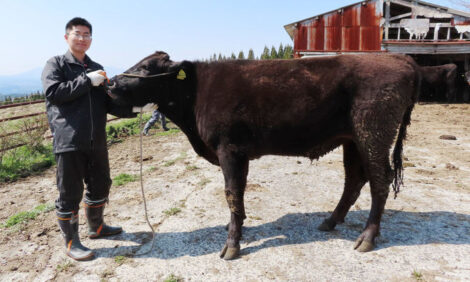



HATCH for Hunger asking all proteins to join in fight against food insecurity
HATCH delivered a record 5.1 million dozen eggs to food banks and pantries in 2022. What will they do next?Part of Series:
Jeff Simmons, CEO of Elanco Animal Health and board chair of HATCH for Hunger, spoke to The Poultry Site’s Sarah Mikesell at Protein Secure: Fighting Food Insecurity event HATCH for Hunger held in Atlanta during IPPE.
How does HATCH for Hunger help the food insecure?
“The people at this convention, we're all connected around animal protein - meat, milk, eggs - and we know the power of it for family,” Simmons said. “We know the difference between starting a morning in a kitchen with a two-egg breakfast for a child versus maybe a sugary bar they pull from a backpack on the bus.”
HATCH for Hunger is a nonprofit organization that takes lower-valued eggs that are bought or donated from producers and gets them to the people and families who need them most.
“Think about a case of medium eggs that aren’t in high demand. HATCH buys these eggs and distributes them to 48 food banks that feed thousands of people. These food banks – and the families they support – are saying ‘I need sustained supply; I can't have eggs that come one month, but not the next.’ HATCH has created a sustained supply by providing eggs to food banks at a discounted price while also providing value back to the egg producer,” Simmons added.
As a nonprofit, HATCH is offering shared value to producers, food banks and pantries as well as to the people and communities they serve. As a result, every week a parent or caregiver can get a dozen eggs and start to develop eating habits for the young children in their lives. This leads to a better diet and better cognitive skills.
“What does it mean? It does mean changing eating habits; it does mean a better morning, better grades, better cognitive skills and better health,” said Simmons. “Today, believe it or not, America has gone back five years in life expectancy according to FDA Commissioner Robert Calif. Why? He cited diet as a major factor. There’s a shift though moving from high-carb and sugary diets to higher protein, lower carb diets. This shift is allowing people to see the great work of our producers, as stewards of animals and land, and creating an amazing food product everybody needs.”
HATCH’s success and what’s next?
“I grew up on a dairy farm. My brother and dad still say profitability is sustainability. It starts there - I think that's really important - HATCH wants producers to be sustainable. I'm excited to say HATCH was one of the larger buyers of medium eggs in 2022,” noted Simmons.
HATCH’s statistics are incredible and growing. The program started in 2015 and since then it has delivered 51 million meals with eggs, and 31 million of the 51 million occurred in 2022.
“That is a statistic that reflects the heart of producers – even in the midst of avian influenza last year. They step up,” said Simmons. “We heard producers today say ‘we do it because it's the right thing to do.’ In 2022, 31 million meals and 48 food banks - that's going to grow substantially.”
Simmons said under the leadership of Danny Leckie, HATCH for Hunger Executive Director, the organization’s five-year plan forecasts going from 31 million meals to 300 million meals by 2027. To meet that goal, HATCH plans to begin to add other proteins, including chicken, beef, pork and milk, to the existing infrastructure of food banks and pantries set up across the country.
“HATCH has the system set up. Now, under Danny’s leadership, HATCH is ready to apply the model and add chicken drumsticks or a different animal protein,” Simmons explained. “But to somebody that is food insecure or doesn't get it, a set of chicken drumsticks changes the evening, just like eggs can change their day in the morning. That's where HATCH is going, and they’re piloting new options going into 2023.”
Simmons said another goal in 2023, in addition to adding other animal proteins, is advocacy. Having spent 33 years in animal health, Simmons says there’s a misunderstanding about US farmers, ranchers and producers - a belief that they're not in this for the good. On the contrary, he believes they are the best stewards of the land, the animal and advocates for the food insecure.
“As a nonprofit, HATCH is going to shout out the story and be the advocate to say, ‘look at the American farmers and international farmers who are feeding people and what they do for the animal and the land,’” Simmons added. “I thank our farmers and ranchers for what they do. These are hard times globally - from war, recession, COVID pandemics, African swine fever, avian influenza. It shows the greatest character and integrity of someone who is in a time of adversity. I've never been more proud to serve farmers, veterinarians and ranchers than now.”
Global expansion opportunity?
Simmons said there is an opportunity for global expansion of the model that HATCH has created.
“The model is not that complicated. It's staying at it, staying in it, getting partners that want to do this,” Simmons said. “It takes the right leadership over time, staff and some great producers, but it's very possible. I would call out to anyone to visit the HATCH website or call its leadership team. They're very willing to share and this can be replicated in another country. I say start small. It was one producer and one or two food banks, and that’s how it all began for HATCH, and it's worked.”
Simmons said he is excited about the decade ahead and sees improved food security. He expects animal health and animal protein to continue to positively impact human health. He says the next decade will focus on environmental health and climate neutral farming.



